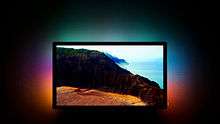Bias lighting
In home cinema and video editing technology, bias lighting is a weak light source on the backside of a screen or monitor that illuminates the wall or surface behind and just around the display.[1][2]

The purpose of bias lighting is to reduce the perceived brightness of the display as a result of the contrast with the slightly illuminated area around it.[1] This reduces the eye strain and fatigue that occurs when viewing a bright display against a very dark background for an extended time,[1] and increases the perceived blackness and contrast of the display.[1][2]
Bias lighting was already used in the early days of television in the form of "TV lamps", often taking the shape of an animal, that were set atop television sets and projected light onto the wall behind the set.[2] As of the 2000s, bias lights often use LEDs, attach to the backside of flat-panel displays, and draw power from a USB or HDMI port.[2] They may also be integrated into the display. Some Philips televisions, for example, feature integrated bias lights since 2002 with the brand name "Ambilight".
Bias lights with a cool white color temperature of 6,500 K match the temperature of most monitors' white color.[1] They are used in professional editing environments and are recommended to maximize the fidelity of the perceived image.[1][2] In home cinema, bias lighting that is no brighter than 10% of the display's brightest spot[2] and with a color rendering index of at least 90 is recommended.[1][2]
References
| Wikimedia Commons has media related to Ambilight. |
- Fitzpatrick, Jason (1 April 2015). "What Bias Lighting Is and Why You Should Be Using It". How-To Geek. Retrieved 30 November 2018.
- Cohen, Simon (10 March 2018). "Make your TV pop with $40 worth of LEDs and the magic of bias lighting". Digital Trends. Retrieved 30 November 2018.